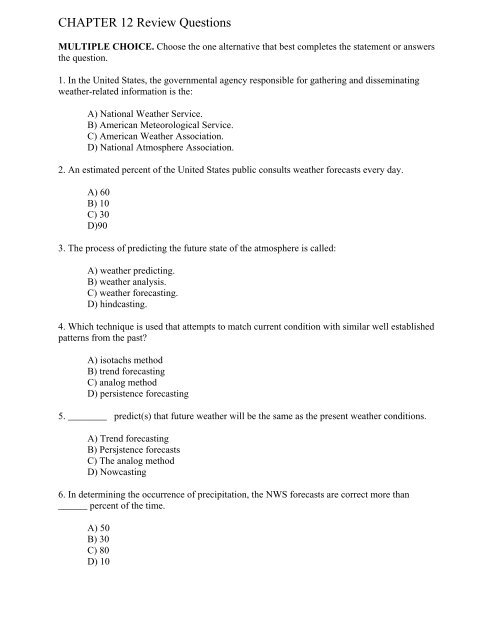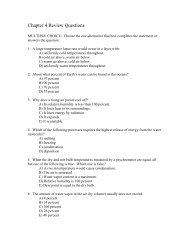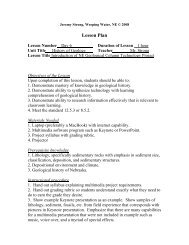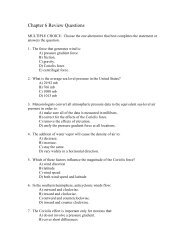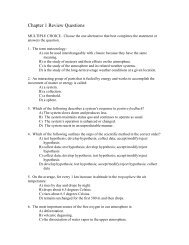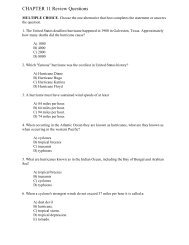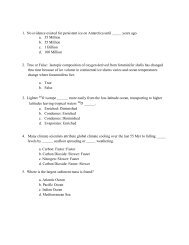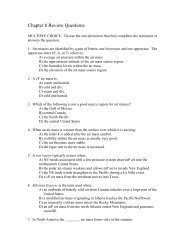CHAPTER 12 Review Questions - Earth and Atmospheric Sciences
CHAPTER 12 Review Questions - Earth and Atmospheric Sciences
CHAPTER 12 Review Questions - Earth and Atmospheric Sciences
Create successful ePaper yourself
Turn your PDF publications into a flip-book with our unique Google optimized e-Paper software.
<strong>CHAPTER</strong> <strong>12</strong> <strong>Review</strong> <strong>Questions</strong><br />
MULTIPLE CHOICE. Choose the one alternative that best completes the statement or answers<br />
the question.<br />
1. In the United States, the governmental agency responsible for gathering <strong>and</strong> disseminating<br />
weather-related information is the:<br />
A) National Weather Service.<br />
B) American Meteorological Service.<br />
C) American Weather Association.<br />
D) National Atmosphere Association.<br />
2. An estimated percent of the United States public consults weather forecasts every day.<br />
A) 60<br />
B) 10<br />
C) 30<br />
D)90<br />
3. The process of predicting the future state of the atmosphere is called:<br />
A) weather predicting.<br />
B) weather analysis.<br />
C) weather forecasting.<br />
D) hindcasting.<br />
4. Which technique is used that attempts to match current condition with similar well established<br />
patterns from the past<br />
A) isotachs method<br />
B) trend forecasting<br />
C) analog method<br />
D) persistence forecasting<br />
5. ________ predict(s) that future weather will be the same as the present weather conditions.<br />
A) Trend forecasting<br />
B) Persjstence forecasts<br />
C) The analog method<br />
D) Nowcasting<br />
6. In determining the occurrence of precipitation, the NWS forecasts are correct more than<br />
______ percent of the time.<br />
A) 50<br />
B) 30<br />
C) 80<br />
D) 10
7. These satellites were placed in orbit over the equator <strong>and</strong> remain fixed over a point on <strong>Earth</strong><br />
because they keep pace with the earth's rate of rotation.<br />
A) Geostationary satellites<br />
B) Automated Surface Observing Systems<br />
C) Polar Satellites<br />
D) Doppler Satellites<br />
8. When upper-air flow produces large-amplitude waves <strong>and</strong> a general ______flow, cold air<br />
moves southward <strong>and</strong> cyclonic activity dominates the weather.<br />
A) North to East<br />
B) North to South<br />
C) West to East<br />
D) West to South<br />
9. The accuracy of day-to-day weather forecasts for periods beyond _____ day(s) is relatively<br />
unreliable.<br />
A) 1<br />
B) 3<br />
C) 5<br />
D) 7<br />
10. The path that cyclonic storms follow (storm track) is usually farther to the south during<br />
A) nighttime.<br />
B) winter.<br />
C) summer.<br />
D) autumn.<br />
11. Why is the pattern of upper-level winds an important part of the forecasting process<br />
A) Jet streams aloft always lead to storms.<br />
B) Surface pressure controls the wind aloft<br />
C) It strongly influences the development of surface storms.<br />
D) Rainfall at the surface corresponds to westerly flow aloft<br />
<strong>12</strong>. Why are some satellites described as being stationary<br />
A) Their altitude never changes.<br />
B) They orbit over the earth's poles.<br />
C) They can only observe stationary weather systems.<br />
D) Their orbital motion matches the earth's rotation.<br />
E) They have no orbital motion.<br />
13. Long range forecasts (monthly or seasonal) include predictions of<br />
A) temperature <strong>and</strong> precipitation.<br />
B) pressure.<br />
C) wind.<br />
D) precipitation.<br />
E) temperature.
14. The development of large, fast computers has allowed this method of weather prediction to<br />
become useful<br />
A) analog<br />
B) numerical<br />
C) synoptic<br />
D) nowcasting<br />
E) persistence<br />
15. Which of the following data is not plotted on a weather chart<br />
A) sky cover<br />
B) temperature<br />
C) cloud height<br />
D) relative humidity<br />
E) dew-point temperature<br />
16. A major drawback of the analog method of weather forecasting is:<br />
A) old weather charts are very inaccurate.<br />
B) the Sun's influence on the weather is not completely understood.<br />
C) compilers are not fast enough to process the data.<br />
D) there are too many variables to match<br />
17. Synoptic charts have isobars plotted at ______ millibar levels.<br />
A) 10<br />
B) <strong>12</strong><br />
C) 1<br />
D) 5<br />
E) 4<br />
18. If there is a 60 percent chance a storm will move into a forecast area, <strong>and</strong> that it will affect 50<br />
percent of that area, the precipitation probability is<br />
A) 60 %<br />
B) 30 %<br />
C) 40 %<br />
D) 10<br />
E) 50<br />
TRUE / FALSE. Write "T" if the statement is true <strong>and</strong> "F" if the statement is false.<br />
19. One of the current deficiencies in weather forecasting, limited observational data, is<br />
being addressed through the use of automated weather instruments called Automated Surface<br />
Observing Systems (ASOS).<br />
20. Until the late 1950s, synoptic weather forecasting was the primary basis for making<br />
weather predictions.


